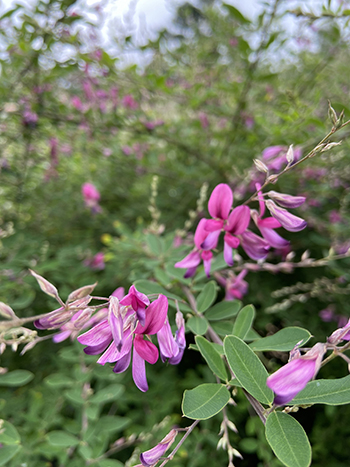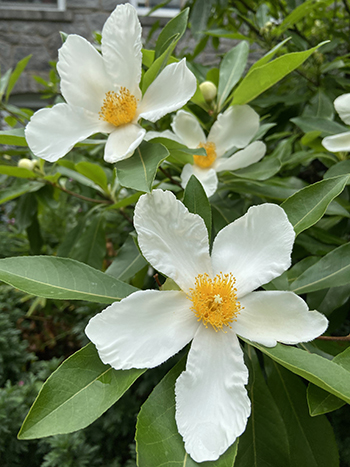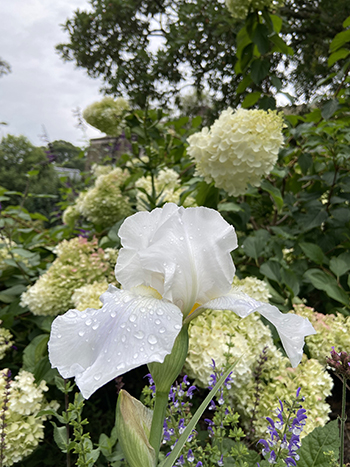
Plants of the Week: August 28

Lespedeza thunbergii ‘Gibraltar’ – bush clover
We tend to think of the year broken into four distinct periods: spring, summer, winter, and fall. But within those seasonal divisions the garden ebbs and flows through its own rhythm. The late August garden seems to be one of pause – the Lycoris have lost their petals and remain green sentinels punctuating the bed, the Joe-Pye weed begins to flop, and the anemones wait in anxious buds. I find myself in a bit of a slump with the plants and garden beds I tend to, resisting the urge to cut back and pull out. However, I work to remind myself of the anticipation that comes before the spring flush, the hope that comes with knowing something good is around the corner.
And in this period of waiting, I began to see signs of the late summer garden through my observation of the bush clover on the wall above the Bond Worth Courtyard. The Lespedeza thunbergii ‘Gibraltar’ is a beacon of what’s to come. I know soon, the fountain-like branches will be covered in rosy-purple pea-like flowers, giving way to much needed garden color. Right now, the bluish-green leaves are only punctuated with a few flowers, but I implore you to watch and wait, because as this woody shrub begins to shine, we will be ushered into the bounty of the late summer garden and a new period of garden wonder. Photo credit: M. Rossman

x Gordlinia grandiflora – gordlinia
Is it a Franklinia? Is it a Camellia? No! It’s the gordlinia! This Zone 7-9 semi-evergreen tree is a nod to the amazing nature of intergeneric hybrids. Pulling the best traits from its mother plant, the Franklinia alatamaha (franklinia) and its father plant Gordonia lasianthus (loblolly-bay), this hybrid developed in 2003 grows more vigorously and has larger flowers than either parent.
Best grown in well-drained soils, the x Gordlinia grandiflora can grow to a height of 20-30 feet with a spread of 8-15 feet and blooms in late summer, early fall. It performs best when protected from the harsh afternoon sun and can be delicate come winter, so a sheltered site is ideal. With clean, matte-white petals and a fuzzy egg yolk-colored center, these eye level blooms are sure to delight. Our 2010 accession is located near the Sproul Observatory above the Tree Peony Collection and is well worth the visit. Photo credit: M. Rossman

Iris ‘Immortality’ – bearded iris
We all love an encore, so give it up for the Iris ‘Immortality’, the reblooming bearded iris located in the Scott Entrance Garden! The stunning, crisp white blooms are this year’s second flush for this particular iris. The combination of the white Iris ‘Immortality’ in conjunction with the inflorescences of the Hydrangea paniculata ‘Silver Dollar’(panicle hydrangea) is a winning duo in our gardens.
There are many bearded irises of all colors that have been bred to produce flower stalks both in spring and then again in late summer. Reblooming irises are a garden treat, but the second, late summer flowering is not guaranteed. While largely dependent upon factors well out of our control, such as weather, climate, soil composition, and geographic location, there are a few things we can do to increase our chances of a second round. Because the plant must gear up and prepare to grow another flush of blooms, they require more water through the spring blooming period and hot summer. It will benefit from a low nitrogen fertilizer after the first blooming ends. Additionally, dividing every 2-3 years in the fall can increase the chances of a second flush. Photo credit: M. Rossman





Robert Roggeveen
Posted at 19:28h, 15 SeptemberA very fine set of articles. Lespedeza does well here in Connecticut. So sad that x Gordlinia can not flourish here.